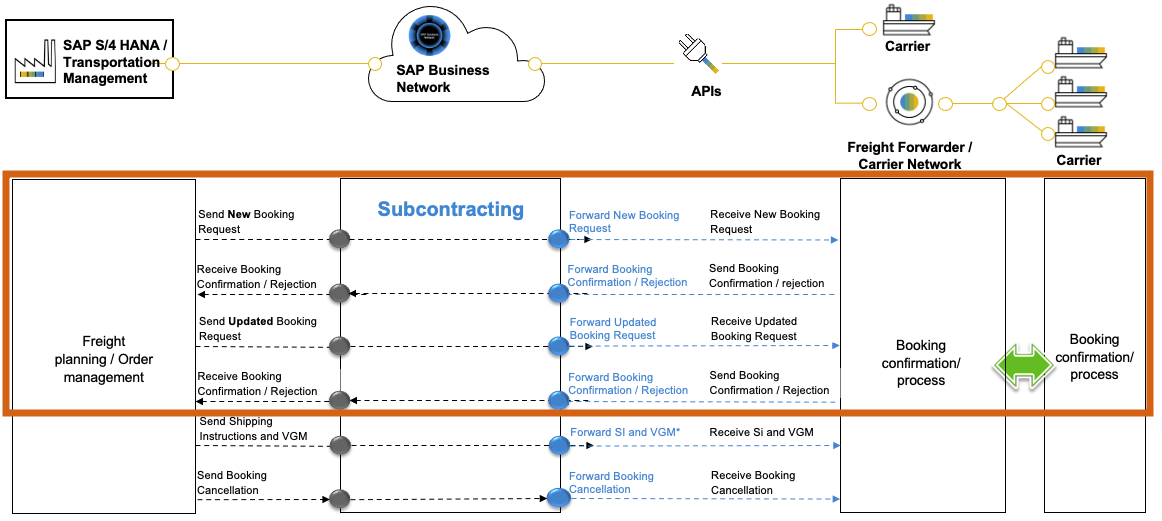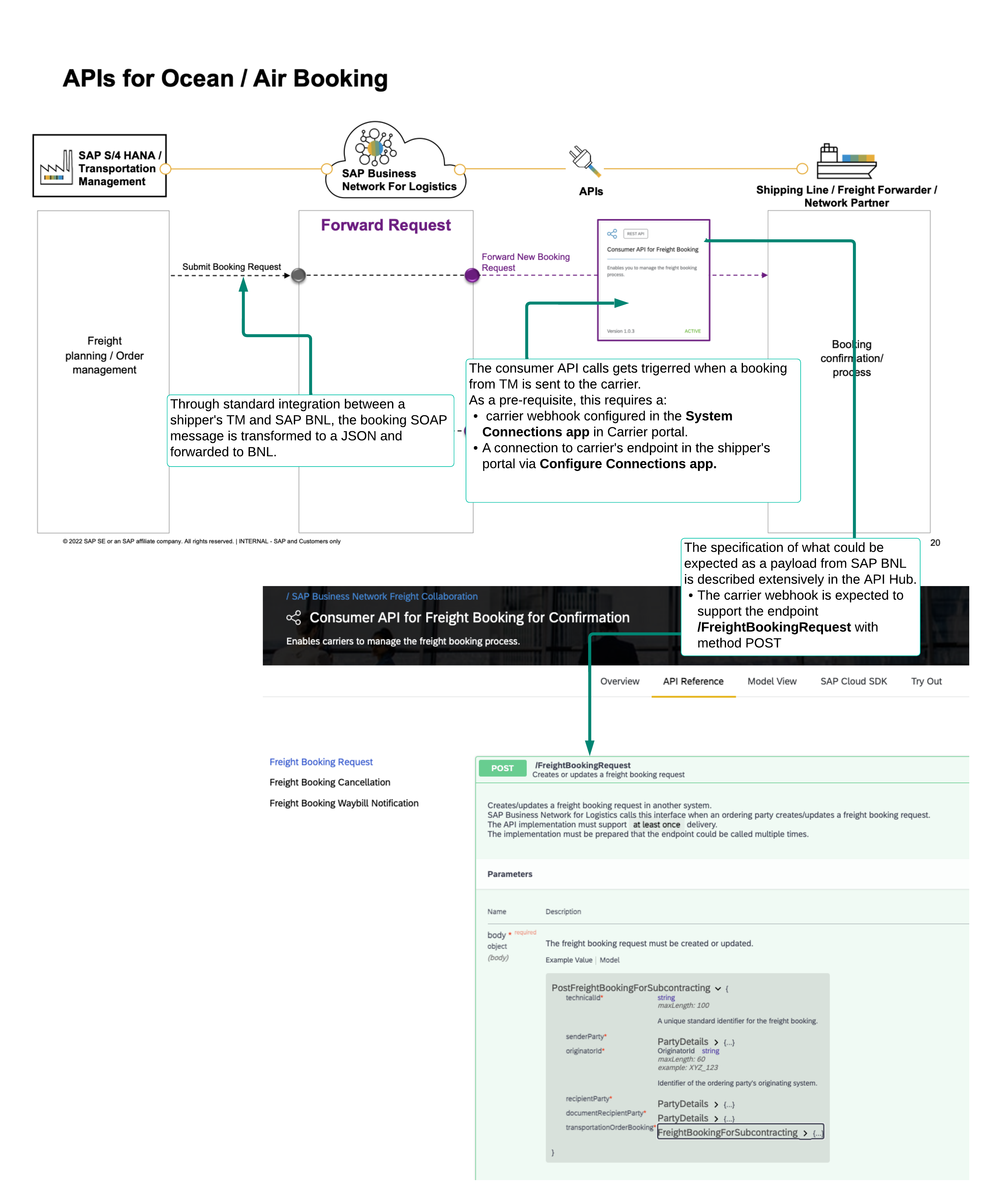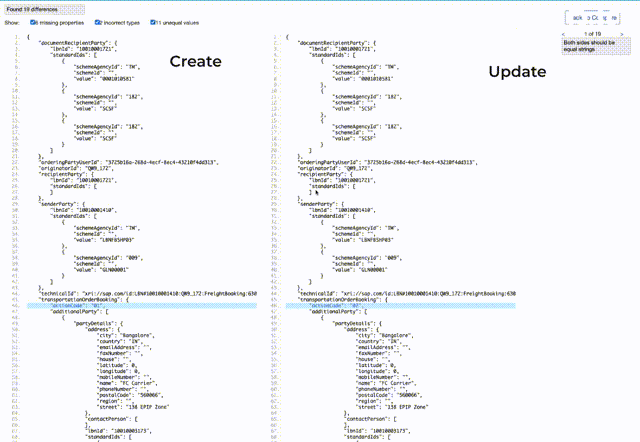
- SAP Community
- Products and Technology
- Supply Chain Management
- SCM Blogs by SAP
- SAP Business Network for Logistics – REST API Inte...
- Subscribe to RSS Feed
- Mark as New
- Mark as Read
- Bookmark
- Subscribe
- Printer Friendly Page
- Report Inappropriate Content
Breaking down the Freight Booking API (Ocean) for Carrier Integration (1/2)
Glossary:
| Acronym | Definition |
| BN4L | Business Network for Logistics |
| LBN | Logistics Business Network (old name for BN4L) |
| TM | Transportation Management |
| API | Application Programming Interface |
| MIL | Manage Integration Logs |
The SAP Business Network Freight Collaboration solution connects shippers and their logistics partners on a secure network for optimized collaboration and insights, integrated tightly with core business processes for efficiency and resilience. More details can be found here.
The Freight booking document is a primary transportation document for Ocean and Air. The processes supported in SAP BN4L for Ocean scenario are explained here. In this post, the focus is on usage of booking API and the minimum data that is required for a successful end-end integration.

Booking Subcontracting process
Pre-requisite
In order for the B2B integration to work, both the carrier and the shipper will have to perform these steps in the same order:
Also, refer blog for tips.
Use Case 1: Booking Confirmation & Updates

Booking confirmation and Updates
As shown above, booking confirmation and updates involves several API exchanges between SAP TM, BN4L, and Carrier systems.
Receiving a booking

An example of a Freight Booking Request that can be used to build the integration.
Breaking down Business Partner details:

Key Business Partners and key field
Note: The technicalId for the tracking process for a Booking would be different from the above. Clients should rely on the Tracking Consumer API call for the relevant technicalId.
In addition to the above, the JSON has other fields within the transportationOrderBooking object, as explained below.

Other Business Partner details
Things to know:
- Refer to the specification for an exhaustive list of Business partner types supported by the API.
- URL as an attachment is not supported yet. Only files are supported.
Responding to a booking

To respond to a booking, refer to the provider API specification that explains the various fields that can be sent to the shipper. In this post, we will focus on the bare minimum that is required for a successful Booking confirmation call.
API endpoint: https://l20398-iflmap.hcisbp.eu1.hana.ondemand.com/http/v1/FreightBookingConfirmation
Method: POST
Authentication: Use the oauth2.0 client credentials to get a token and pass on the bearer token to the API.

While the below shows the minimum mandatory information required, there are more fields in the payload that can be sent back as part of the confirmation so that the shipper receives it.
#Sample Booking confirmation payload (When carrier is sending the confirmation call):
{
"technicalId": "xri://sap.com/id:LBN#10010001410:QW9_172:FreightBooking:6300003001-0001010581",
"senderParty": {
"lbnId": "10010001721<Carrier>"
},
"recipientParty": {
"lbnId": "10010001721<Carrier>"
},
"documentRecipientParty": {
"lbnId": "10010001410<Shipper>"
},
"transportationOrderBooking": {
"freightBookingId": "6300003001",
"acceptanceStatusCode": "AP",
"baseBusinessTransactionDocumentReference": {
"id": "6300003001",
"typeCode": "1122"
}
}
}#Sample Booking confirmation payload (When Network Partner is sending the confirmation call)
{
"technicalId": "xri://sap.com/id:LBN#10010001410:QW9_172:FreightBooking:6300003001-0001010581",
"senderParty": {
"lbnId": "10010002311<Network Partner>"
},
"recipientParty": {
"lbnId": "10010001721<Carrier>"
},
"documentRecipientParty": {
"lbnId": "10010001410<Shipper>"
},
"transportationOrderBooking": {
"freightBookingId": "6300003001",
"acceptanceStatusCode": "AP",
"baseBusinessTransactionDocumentReference": {
"id": "6300003001",
"typeCode": "1122"
}
}
}
Of course, one could send more than what is shared above, in that case, make sure you understand the datatypes of the various fields published in the API spec above and the supported code lists for some of the fields (egs: UOM). BN4L only accepts these whitelisted values.
Note: Shippers need to enable carriers to send attachments. Without this, carriers will not be able to send attachments.
Things to be aware of with this API:
- The API will complain with the below error if you send the wrong carrier LBN ID in the payload

- Gives a 401 Unauthorised if you send the wrong credentials, as shown below.

- Sometimes, you may send the wrong shipper LBN ID, miss a mandatory field in the payload, or send incorrect data. In some cases, you may receive a 200 OK, and it may look like the API call was successful, but there are other asynchronous calls that happen in the background which may fail. Hence, these are logged in the Manage Integration Logs app. Make sure to check the app, if you feel, your updates are not going through. Or if the shipper complains that the updates are not received.
In the below case, the wrong recipient LBN IDs were sent.

Note: The shipper will also have an equivalent Manage Integration Logs application where they will be able to monitor calls between the Network and TM. If there are no supporting logs in your MIL application, you can also double-check for any logs with the shipper.
Receiving updates to a booking
Updates to a booking can be done by a shipper at any point, typically before or after confirmation. Usually, changes are not made once the booking is in execution. BN4L, uses the same POST API used to receive a booking to also send updates. The payload has "actionCode" field which distinguishes if it is a Create or an Update.
"01" - Create | "02" - Update

More Booking scenarios/use cases are continued at SAP Business Network for Logistics – REST API Integration series: Post #2
Subscribe for updates via the RSS feeds. Also, subscribe to the tags to get updates on new content.
- SAP Managed Tags:
- SAP Business Network for Logistics,
- SAP Transportation Management
You must be a registered user to add a comment. If you've already registered, sign in. Otherwise, register and sign in.
-
Business Trends
169 -
Business Trends
25 -
Catalog Enablement
1 -
Event Information
47 -
Event Information
5 -
Expert Insights
12 -
Expert Insights
47 -
intelligent asset management
1 -
Life at SAP
63 -
Product Updates
500 -
Product Updates
68 -
Release Announcement
1 -
SAP Digital Manufacturing for execution
1 -
Super Bowl
1 -
Supply Chain
1 -
Sustainability
1 -
Swifties
1 -
Technology Updates
187 -
Technology Updates
18
- 4 Lessons from Moms in Risk-Resiliency for Supply Chain Professionals in Supply Chain Management Blogs by SAP
- SAP S/4HANA 2022 - Segmented generic article and variants not supported in advanced planning in Supply Chain Management Q&A
- TOP 3 future trends to watch in data analysis in Supply Chain Management Blogs by Members
- Can’t Miss Asset and Service Management Sessions at SAP Sapphire 2024 in Orlando in Supply Chain Management Blogs by SAP
- Why Logistics Visibility is Best with SAP Business Network Global Track and Trace in Supply Chain Management Blogs by SAP
| User | Count |
|---|---|
| 15 | |
| 5 | |
| 4 | |
| 4 | |
| 4 | |
| 3 | |
| 3 | |
| 3 | |
| 2 | |
| 2 |